|
BULB LOG 23 --- 8th June 2006
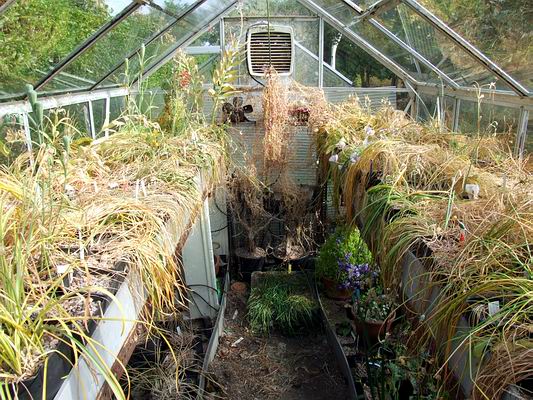
Bulb house 4.6.06
I have now stopped watering in the bulb house as it starts to resemble a hay field. Except, that is, for the few plants that I showed you in log 21, Nothoscordum ostenii and Allium yosemitense, and another couple that you can just pick out in this picture if you search.

Tropaeolum azureum
Below the staging on the right is our original plant of Tropaeolum azureum, raised from John Watson seed sown in 1989 and is still going strong despite having to grow in this less than favourable position. I should qualify that statement: the plant is perfectly happy scrambling and climbing as it does all across the other pots to reach the light at the window - flowering profusely as it goes. My intention was for it to grow artistically up and around the attractive piece of knurled drift wood and look a perfect picture for the Aberdeen Show two weeks ago. The problem was I did not have the space to bring it up to the light nor the time, or is that discipline, to turn it regularly to achieve an even flowering all around which would have produced a prize winning plant. The facts are that the leaves of this plant burn quickly when exposed to sun under glass and it prefers to scramble through the shaded undergrowth just pushing its flowers up to enjoy the full strength of the sun shine.
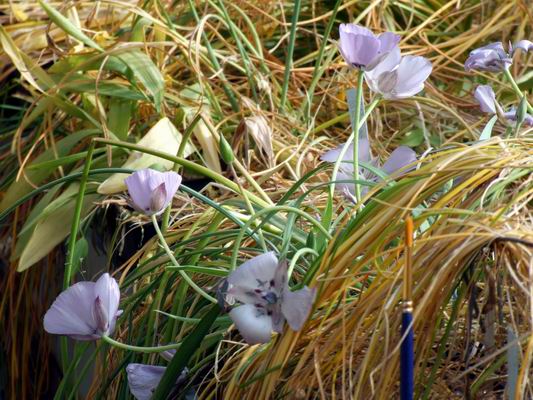
Calochortus uniflorus
Another late grower in our 'hay field' is Calochortus uniflorus. Again, grown this way it would not make a very pretty sight on the Show Benches, but the plant is perfectly happy growing, as it would in the wild, through other plants to get its flowers into the sunshine and seen by the pollinators.

Calochortus uniflorus flower
And who could miss such a stunning flower with anthers of the most amazing colour of blue. All of our bulbs in the bulb house have had to grow in close competition with each other and as a result have become etiolated during growth but by the bulges in the sides of the plastic pots it has not stopped their bulbs increasing in size and number.
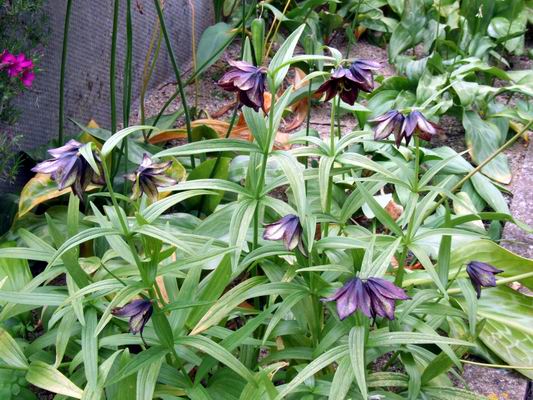
Fritillaria camschatensis Alaskan form
I promised to show you the Alaskan form of Fritillaria camschatensis when it flowered and they are now open. The leaves tend to be longer and narrower than the Eurasian forms but it is the green on the outside of the petals that is the most consistent difference between the Geographic forms.
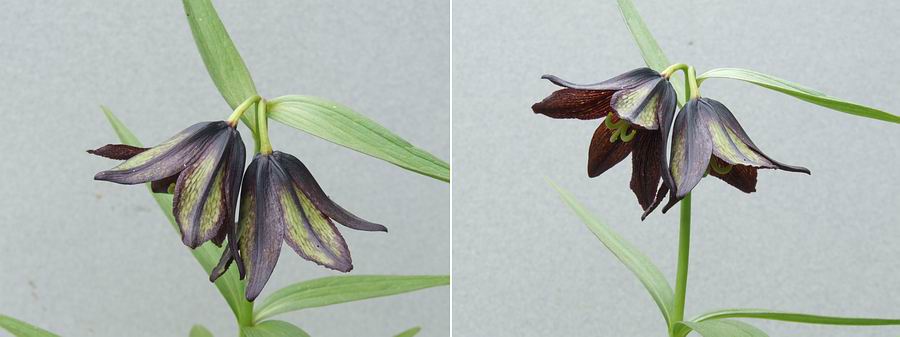
Fritillaria camschatensis Alaskan flowers
Look inside the flowers and they are as black as the Eurasian ones with no hint of the green markings on the reverse.
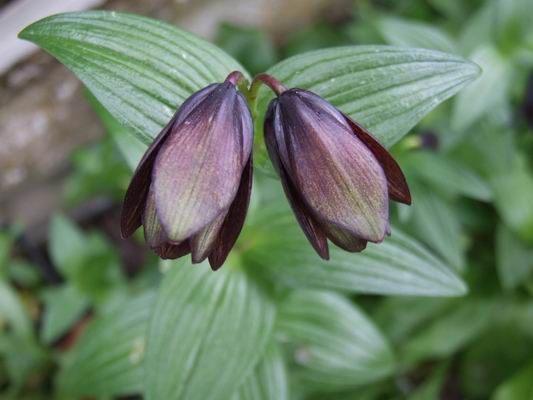
Fritillaria camschatensis 'Tomari'
Fritillaria camschatensis 'Tomari' is an interesting form that I got from Janis Ruksans that was collected in the South part of Sakhalin Island near Tomari. The outside of its flowers have a green colouration when in bud, this turns black as the flowers open fully showing a seamless link between the two groups. The interior of all the Fritillaria camschatensis we have grown have been evenly dark and are also deeply ridged which adds to the beauty of this dramatic late flowering fritillary.

Fritlillaria lixianensis
One of the Chinese species, Fritlillaria lixianensis, also flowers in June. Grown in a frame that is left open for most of the year it has not increased very quickly and to date we have only ever had a single flowering stem which despite my efforts with the paint brush has not yet set seed - here is hoping for success this season. If you are wondering what the dark mark on the stigma is, I was too, it was only when I viewed it on the PC screen that I saw it was a bug of some kind.

Scoliopus bigelowii in seed
I have to collect the seed of Scoliopus bigelowii before the capsules disintegrate for two reasons. Firstly when they are fully ripe the capsules rapidly crumble and the seed is shed but more importantly something eats them off and I am just left with the flower stem minus the seed pod.

Scoliopus bigelowii seed pods
It is best to collect them as they start to turn reddish but the seed is also perfectly ripe and viable in the greener capsules and yes you have spotted one of the culprits that eats my seed harvest. I always take a length of stem with them which helps the ripening process and after a few days the capsules can be opened to collect the seed.

Scoliopus hallii seed
The same is true for Scoliopus hallii. I collected these, removed the seed from the pods (which is a very easy job, just remove the top and they can be shaken out) and sowed them into a seed pot. Scoliopus, like Trillium seeds, are better sown fresh.
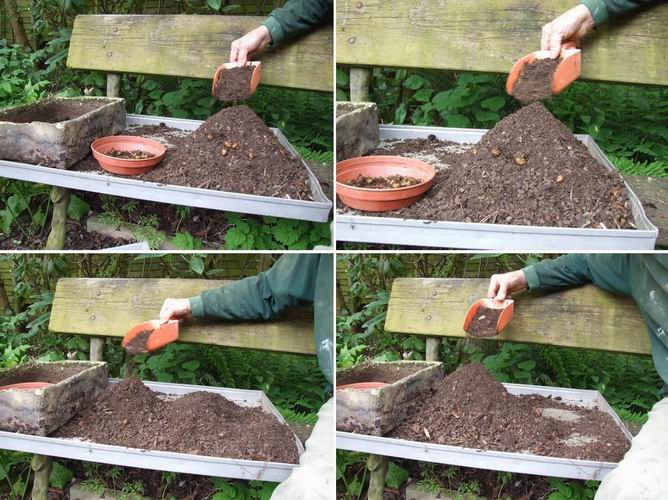
Sorting by chaos
Another job this week was to plant out flowering sized Corydalis bulbs from the seed box into the garden. The first task is to find them in all the compost and the method I employ is what I call 'sorting by chaos'. I tip the contents of the box onto a big tray and with a scoop start to make a conical hill. Scoop by scoop I build up the hill and the small bulbs run down the outside towards the bottom where I can easily spot and collect. Once I have completed my hill I go through the whole process again forming another hill by the end of the second hill I am confident that I have collected all the corydalis bulbs.
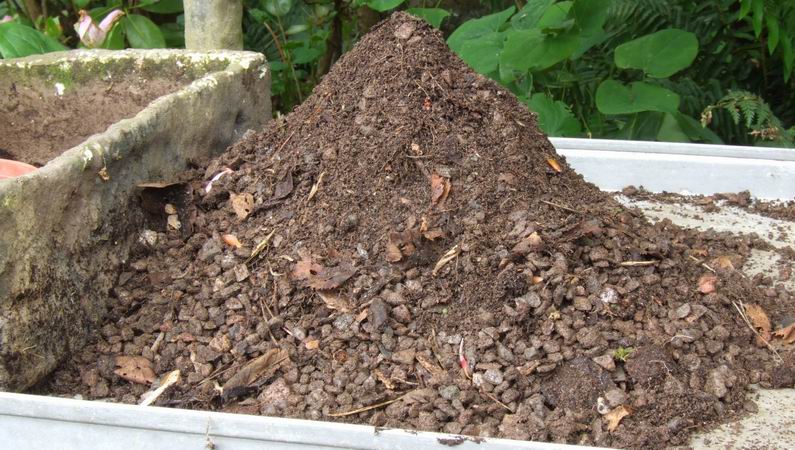
Conical hill
You can see how all the larger particles, like the gravel, fall further down from the top than the fine material and the bulbs being semi rounded fall to the bottom. Why chaos, well I remember being taught about 'Chaos Theory' and the conical hill was used to illustrate the principal that everything could build up to a certain level and then it would crumble - you cannot continue to increase the height of the conical hill without extending the size of its base.
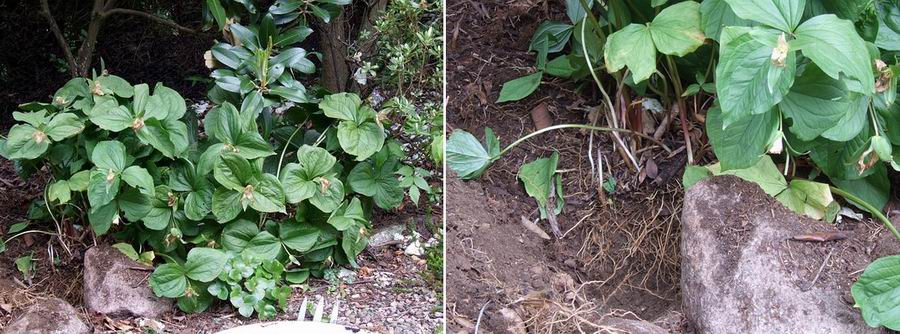
Trillium grandiflorum clump
Brutal as it may seem I am now splitting some of our larger clumps of Trillium grandiflorum. This is the ideal time as the new roots that the plant needs to grow next year will start to emerge soon and I do not want to risk damaging them. I also discovered just how dry the plants are growing at the base of trees and rhododendrons.
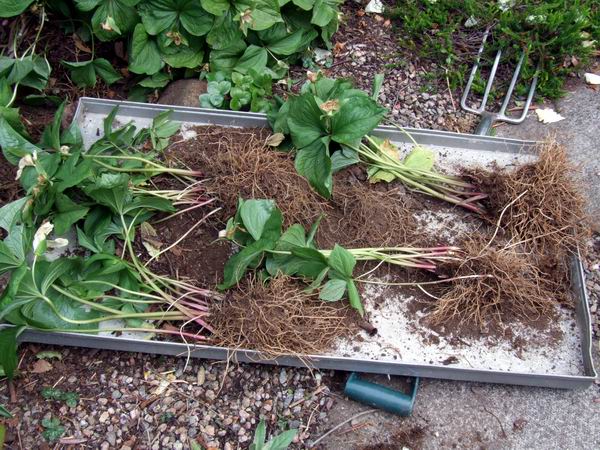
Trillium grandiflorum split up
One clump has been split into four new ones without disturbing the roots too much and now they are planted into nice new moist compost they will pick up and are still likely to set seed for me.

Woolly beastie
A horror picture to end with is like something from Dr. Who - a woolly beastie from science fiction. No this is a woolly aphid I found on one of Maggi's house orchids and I wanted to see how big I could get the picture. Anybody know which end is the front?
^ back to the top ^
|

